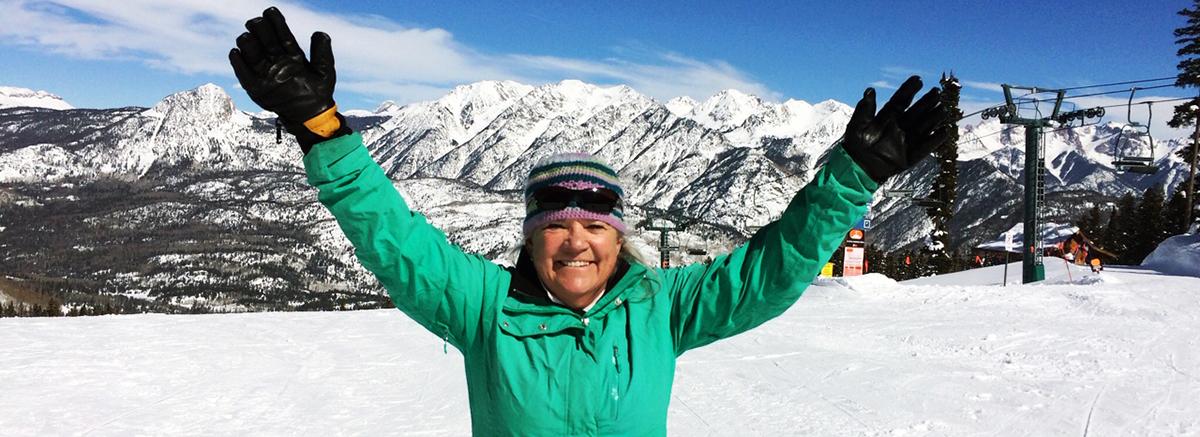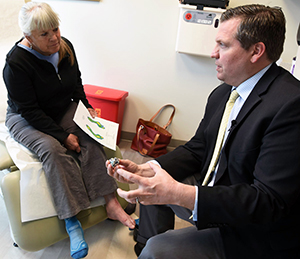
Back on her Feet
Custom-designed ankle repair is perfect fit for Colorado woman
By Todd Neff
(November 2019)If the ankle is a lever, the talus is its fulcrum. It’s an oddly shaped lump onto which the bones of the lower leg drive the body into the bones of the foot. By late 2018, the fulcrum in Deanne “Dee Dee” Carlson’s left ankle had long since given in to the punishments its owner had imparted upon it, and it was dead and crumbling. Until recently, the best option was to fuse the ankle with enough screws to build a deck, which would leave ankle about as flexible as a deck.
A BETTER WAY
Deep in Dee Dee Carlson’s ankle now resides a roughly two-pound, polished nugget of shiny cobalt chromium. It was 3D printed by New Jersey-based Additive Orthopaedics, based on a mathematical mirror image of CT scans of her healthier right ankle.
In November 2018, Kenneth Hunt, MD, a University of Colorado School of Medicine surgeon specializing in foot and ankle orthopedics and the medical director of the UCHealth Foot and Ankle Center in Denver’s Stapleton neighborhood, installed the metallic talus in Carlson’s ankle. He also redid the failed ankle replacement during the procedure at UCHealth University of Colorado Hospital on the Anschutz Medical Campus. The personalized-medicine talus replacement was the first such surgery done at UCHealth and among the first in Colorado. It won’t be his last, Hunt says.
“I think it’s a much better solution than previous approaches,” he said.
ANKLE BASHER

by Todd Neff for UCHealth.
You can’t blame Carlson’s talus, really. She may stand just five feet tall, but the 63-year-old has been a bona-fide ankle basher for decades. The Durango resident was a soccer player in her youth, a tenacious wing defender at Colorado College, and then on several competitive teams into her forties. She dribbled and kicked through more ankle sprains and strains than she can count. The pounding didn’t abate much as she transitioned to trail running as her career as a veterinarian progressed.
By her mid-fifties, the cartilage in Carlson’s ankles had worn away. She had her left ankle surgically replaced in April 2012; the right was done a year later. She stopped trail running, but biking the roads and hiking the trails of southwestern Colorado remained passions, and she skied all winter at Purgatory Resort, both for fun and as part of her duties as a ski-patrol emergency medical technician.
Her right ankle replacement held firm. But with time, the talus in the left ankle died of avascular necrosis, in which bone damage stopped already limited blood supply to the talus, killing the bone. It collapsed, shifting the titanium base plate of the ankle replacement down and toward her midline (technically speaking, medially). Things that were supposed to glide now grinded and clattered against each other.
The pain was such that, by last fall, her hikes in search of mushrooms, which might have otherwise brought hours of mycological meandering among the lodgepole pine, ended abruptly.
“I’d be pretty much in tears by the time I was out for 20 minutes,” Carlson said. “Every step hurt, and there was huge swelling on the medial side of my ankle.”
PERSONALIZED METAL
She was referred to Hunt, who recognized that ankle fusion would seriously limit someone as active as Carlson, Hunt said. They agreed that a new 3D-printed talus was the most promising option.
Additive Orthopedics created three versions of Carlson’s talus: one sized exactly like the one in her right ankle, one slightly smaller, and one slightly larger. Hunt would use the one that fit best. Typically, the shiny metal talus, once inserted, fits in like a puzzle piece and is held in place by the neighboring bones. In Carlson’s case, because of the shifting that had happened before the surgery, the new talus also had a titanium baseplate that Hunt screwed into Carlson’s heelbone (calcaneus). The base of the new ankle replacement hardware sat on the metal talus, and Hunt also replaced the portion drilled into Carlson’s tibia. The surgery went well; now it was a matter of rehabilitating the ankle.
On April 29, Carlson was back for a periodic visit with Hunt and colleagues at the UCHealth Foot and Ankle Center – Stapleton.
The 11 a.m. appointment started with a walk across force plates and pressure-tracking mats in the center’s
clinical motion and performance laboratory. Eight cameras tracked reflective spheres the size of cereal puffs that UCHealth athletic trainer Danielle Lewis and biomedical engineer Sara Andrews had painstakingly adhered to Carlson’s feet, ankles,
legs, knees, and hips. The idea is to assess how the kinetic chain, as it’s called, from Carlson’s feet on through to her waist, was faring five months post-surgery. To the casual observer, she walked normally; the fusion of the lab’s
various inputs would conclude much the same.
BACK TO THE MOUNTAINS
In the exam room, Carlson told Hunt that she had been skiing since February 28. She reminded him that, shortly after surgery, he had told her that, if she rehabbed vigorously and the ankle progressed, she might even get a few runs in by the spring. It had given her a goal toward which she diligently rehabbed. She had since been out skiing another 15 days, she added.
“You took some liberties there, which I appreciate,” Hunt said. “And that’s more days than I’ve got.”
Carlson still has work to do. Hunt is looking for a few more degrees of motion in the ankle, so he wrote up instructions to Carlson’s physical therapist in Durango for more stretching and strengthening. Hunt reminded Carlson that it usually takes about a year to fully strengthen and heal after such a surgery, although additional, incremental gains can happen after that. She’s on track for a great outcome, he told her.
“I think we’ll get many years of activity, and you’re doing really well,” he said. Carlson says she’s walking almost completely pain-free.
“I had expectations, but they weren’t this high,” she said. Carlson planned stay in Denver with sister Lisa Carlson for the next couple of days, but her mind was already on the mountains.
“I’m thinking of going up to A-Basin on Wednesday morning,” she said.
This article originally was published in UCHealth Today